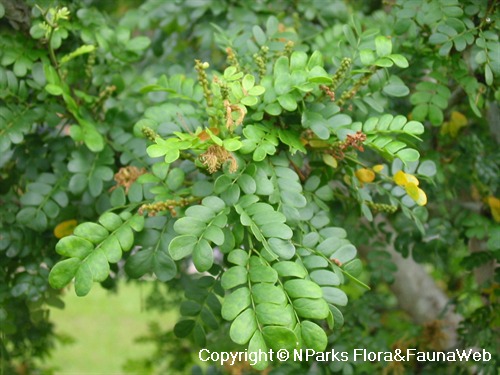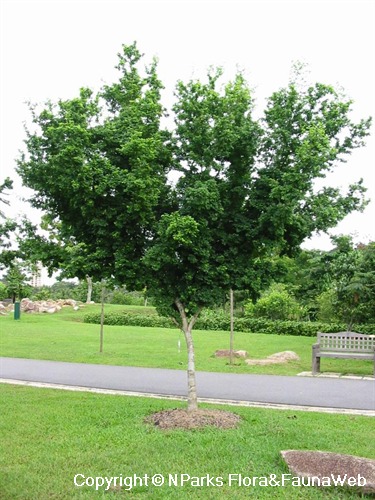
Back
Ebenopsis ebano (Berland.) Barneby & J. W. Grimes
| Family Name: | Fabaceae (Leguminosae) |
| Synonyms: | Chloroleucon ebano, Zygia flexicaulis, Ebenopsis flexicaulis, Ebenopsis caesalpinioides, Mimosa ebano, Pithecellobium ebano, Pithecellobium flexicaule, Ebenopsis confinis, Acacia fexicaulis |
| Common Name: | Texas Ebony, Ebony Blackhead, Ape's Earring, 弯茎猴耳环 |
Name
Classifications and Characteristics
| Plant Division | Angiosperms (Flowering Seed Plants) (Dicotyledon) |
|---|---|
| Plant Growth Form | Shrub, Tree (Small (6m-15m), Shrubby (1m-5m)) |
| Lifespan (in Singapore) | Perennial |
| Mode of Nutrition | Autotrophic |
| Plant Shape | Vase, Rounded |
| Maximum Height | 12 m |
| Maximum Plant Spread / Crown Width | 12 m |
| Tree or Palm – Trunk Diameter | 0 to 0 |
Biogeography
| Native Distribution | USA (Texas to Florida), Mexico |
|---|---|
| Native Habitat | Terrestrial (Grassland / Savannah/ Scrubland, Desert / Semi-Desert) |
| Preferred Climate Zone | Tropical, Sub-Tropical / Monsoonal |
| Local Conservation Status | Non-native (Horticultural / Cultivated Only) |
Description and Ethnobotany
| Growth Form | A woody and evergreen multi-stem shrub to a tree that grows up to 12 m tall. |
|---|---|
| Crown | Spreading crown. |
| Trunk | Smooth bark when young, turning rough and fissured with age. |
| Foliage | Pinnately compound leaves arranged alternately along the stem, with 3 - 5 pairs of oblong to obovate leaflets. Leaflets are green, stipular spines hidden under foliage. |
| Stems | Twigs are arranged in zig-zag pattern. |
| Flowers | Small and fragrant, cream-coloured flowers in dense and slender spikes, terminally located. Flowers attract bees. |
| Fruit | Fruits are dark brown pods, measuring 15 - 30 cm long. Fruits are sometimes curved. |
| Habitat | Found in sandy soils, and grasslands. |
| Cultivation | Seeds are covered by hard epiderm (coat), therefore requires scarification to helps in germination. |
| Ethnobotanical Uses | Food (Herb or Spice): Seeds eaten and pod shells roasted as coffee substitute in Mexico. Timber & Products: Used in woodworking for its high-strength oily timber that finishes naturally to a high lustre. |
Landscaping Features
| Desirable Plant Features | Ornamental Flowers, Fragrant (Flowers) (Day) |
|---|---|
| Landscape Uses | Container Planting, Suitable for Bonsai, General, Focal Plant |
| Thematic Landscaping | Naturalistic Garden |
| Usage Hazard - Cons | Spines/Thorns - Stem/Branch |
Fauna, Pollination and Dispersal
| Seed or Spore Dispersal | Abiotic (Explosive Dehiscence) |
|---|
Plant Care and Propagation
| Light Preference | Full Sun |
|---|---|
| Water Preference | Little Water |
| Plant Growth Rate | Moderate to Slow |
| Rootzone Tolerance | Drought Tolerant, Fertile Loamy Soils, Well-Drained Soils, Poor Infertile Soils |
| Maintenance Requirements | Moderate |
| Propagation Method | Seed |
Foliar
| Foliage Retention | Evergreen |
|---|---|
| Mature Foliage Colour(s) | Green |
| Mature Foliage Texture(s) | Smooth |
| Prominent Young Flush Colour(s) | Green |
| Young Flush Texture(s) | Smooth |
| Foliar Modification | Spine (axillary), Stipule |
| Foliar Type | Compound (Even-Pinnate) |
| Foliar Arrangement Along Stem | Alternate |
| Foliar Shape(s) | Non-Palm Foliage (Ovate, Oblong) |
| Foliar Venation | Pinnate / Net |
| Foliar Margin | Entire |
| Leaf Area Index (LAI) for Green Plot Ratio | 3.0 (Tree - Intermediate Canopy) |
Non - Foliar and Storage
| Trunk Type (Non Palm) | Woody |
|---|---|
| Bark Colour(s) | Grey |
| Mature Bark Texture | Smooth |
| Stem Type & Modification | Woody |
| Root Type | Underground (Tap Root, Fibrous Root) |
Floral (Angiosperm)
| Flower & Plant Sexuality | Bisexual Flowers |
| Flower Colour(s) | Cream / Off-White, Yellow / Golden |
|---|---|
| Flower Grouping | Cluster / Inflorescence |
| Flower Location | Terminal |
| Flower Symmetry | Radial |
| Inflorescence Type | Spike |
| Flowering Habit | Polycarpic |
Fruit, Seed and Spore
| Mature Fruit Colour(s) | Brown |
|---|---|
| Fruit Classification | Simple Fruit |
| Fruit Type | Dehiscent Dry Fruit , Legume / Pod |
| Mature Seed Colour(s) | Black |
Image Repository
Others
| Master ID | 1575 |
|---|---|
| Species ID | 2868 |
| Flora Disclaimer | The information in this website has been compiled from reliable sources, such as reference works on medicinal plants. It is not a substitute for medical advice or treatment and NParks does not purport to provide any medical advice. Readers should always consult his/her physician before using or consuming a plant for medicinal purposes. |

